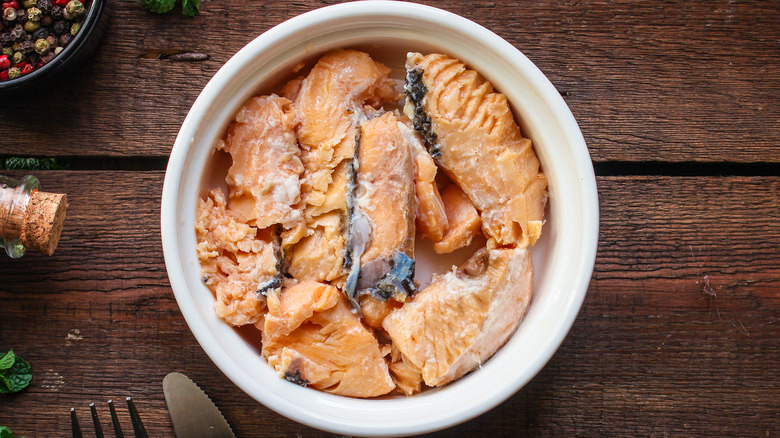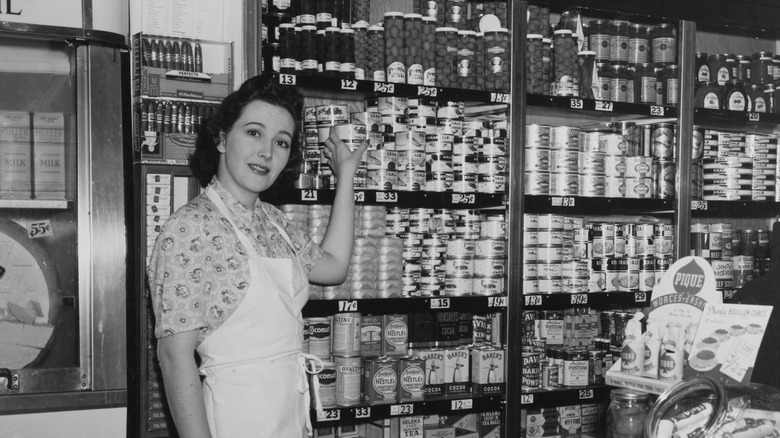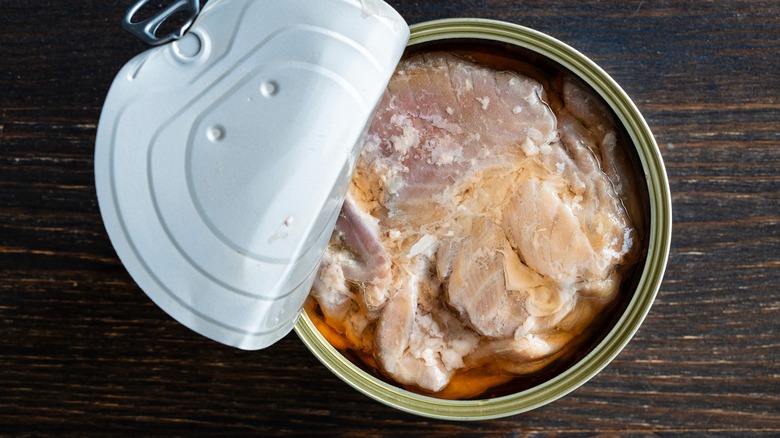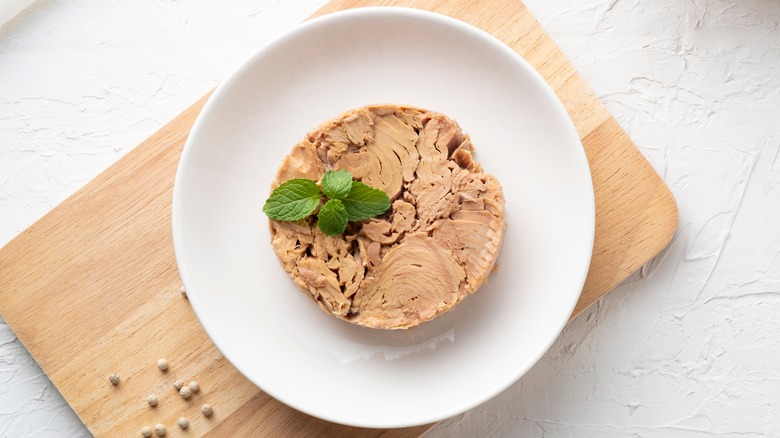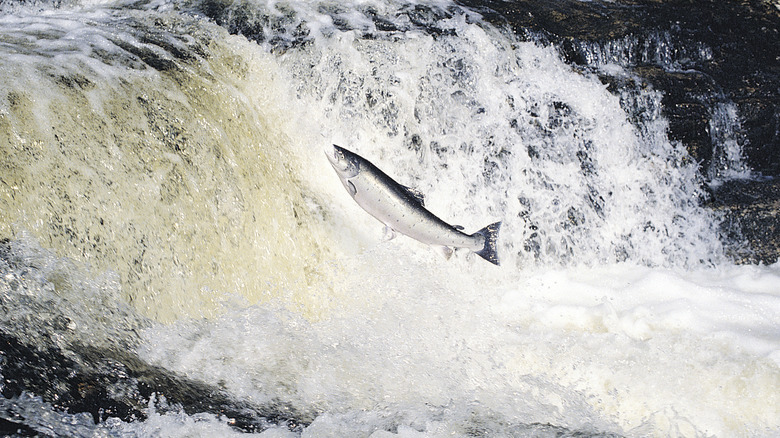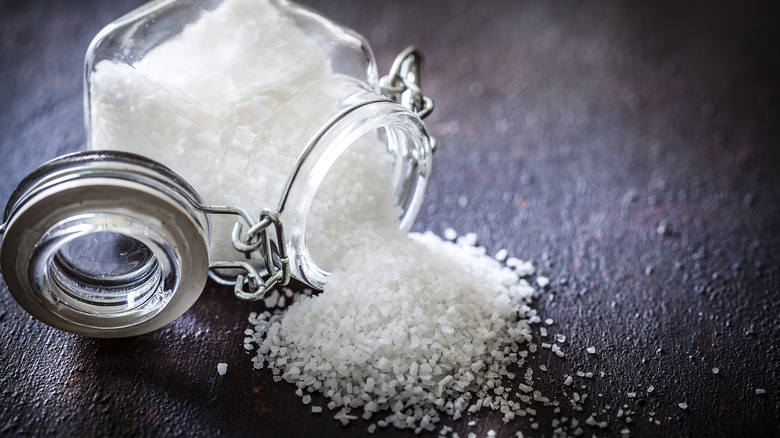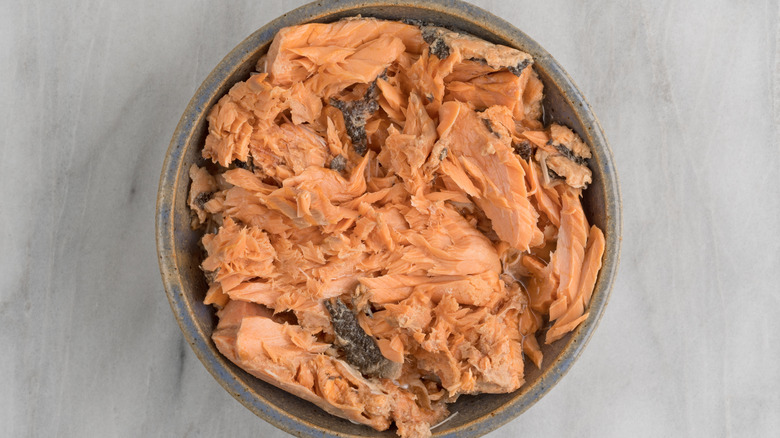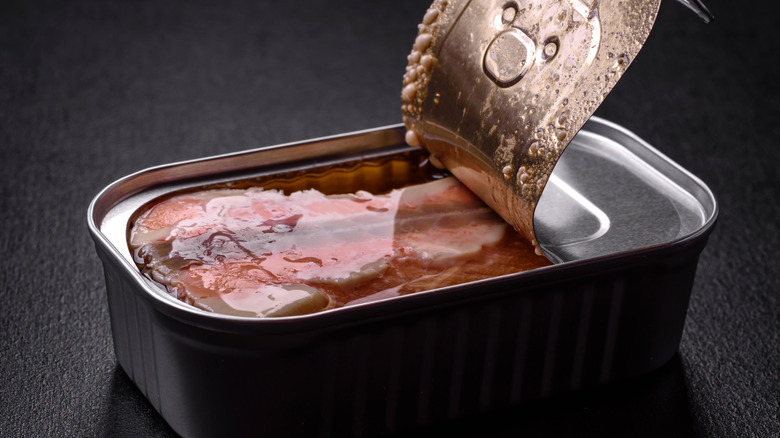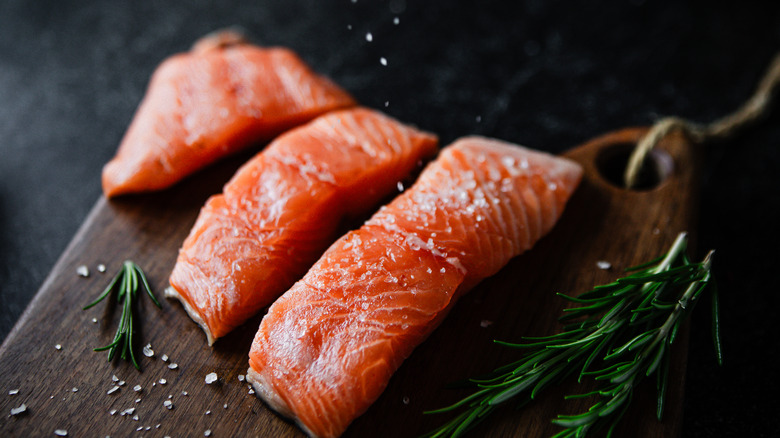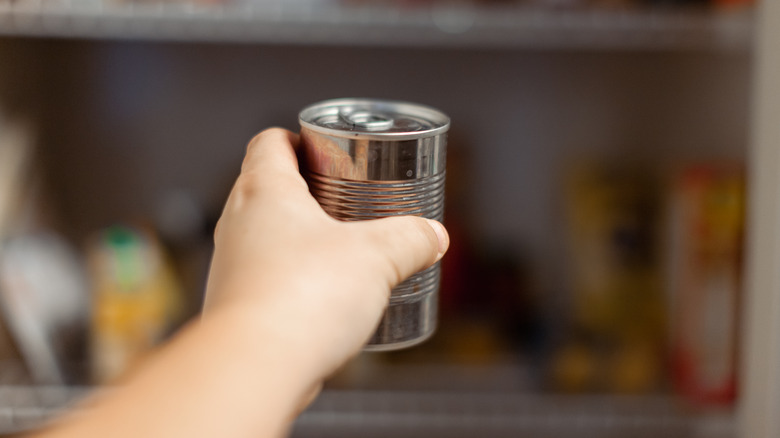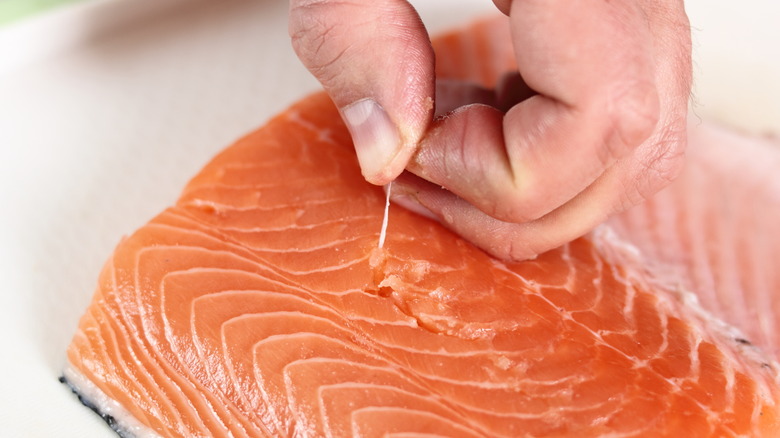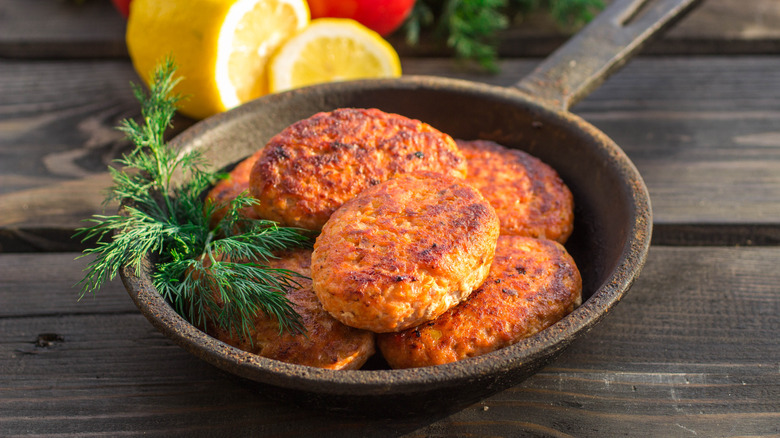11 Facts You Should Know About Canned Salmon
There are many things to love about canned fish, and canned salmon is one of the best types out there. Buying canned salmon is an affordable way to enjoy the omega-3-rich fish, and with minimal preparation. Not only is it nutritious, but the canning process preserves its wholesome qualities and nutrients, allowing you to enjoy it anytime, anywhere, for years after you've bought it. Plus, its versatility and precooked nature means that you can throw it into a mind-boggling amount of dishes in mere seconds.
Despite these positive qualities, canned salmon remains somewhat of an underdog in the canned fish world, with folks still reserving their tinned seafood purchases for tuna or anchovies. That could be down to the fact that we don't know enough about it. Well, not anymore. We're here to give you the lowdown on everything you need to know about canned salmon, including insight from Henry Lovejoy, the president and co-founder of EcoFish, who has over a quarter of a century's experience in bringing canned fish to the market, including in gourmet tinned meals under the Freshé brand name. Let's dive in and get to know this underrated product.
1. Canned salmon's history goes back two centuries
Although canned salmon can feel like a very modern invention, its history extends back further than you think. Salmon has been canned for approximately 200 years, with the first canning outfit said to have popped up in Aberdeen, Scotland, in 1824. It didn't take long for it to make its way over to North America, where, 15 years later, salmon canneries started operating in New Brunswick and Maine.
It was in California, however, where salmon canning truly took off. Brothers George and William Hume and their friend Andrew Hapgood, a tinsmith and fisherman, saw a gap in the market for canned salmon on the West Coast. They began operating in the Sacramento River area in 1864 before moving their business to the Columbia River in 1866, due to the more favorable numbers of salmon there. Although their business was initially plagued by production problems (with a large proportion of their cans bursting in their first year), the canned salmon industry's early foundations were cast. Before long, the product started spreading to every corner of both the country and the globe, and more people started to enjoy the convenience of this canned fish.
2. Canned salmon remains highly popular worldwide
Canned salmon might feel like a niche product, but that's far from the case. It maintains a high level of popularity around the world and is only projected to become more lucrative as time goes on. In 2022, the global canned salmon market was valued at $4.5 billion, according to a report by Fact.MR. This figure is predicted to double by 2032, rising in value year-on-year by 7.1% to reach a whopping $9 billion.
This rise in popularity is attributed to changing lifestyles and an increase in urbanization, which is causing more customers to switch to the convenient, nutritious foodstuff. Better access to online shopping, for both customers and retailers, has also been a driving factor behind its increasing sales.
Certain world events have also been behind canned salmon's increased appeal. For example, in 2020, sales of Alaska canned salmon skyrocketed by a massive 30.3%, as reported by the Anchorage Daily News. The reason? The COVID-19 pandemic. The uncertainty of the period and how it might affect food supply chains arguably drove people to stock up on preserved proteins like this one, just in case. Interestingly, there's been a lasting effect from this sales boost, with people making repeat purchases after falling in love with the taste of a product that they may not have bought previously.
3. Nutritionally, canned salmon is similar to canned tuna
Canned tuna and canned salmon are two of the most popular types of preserved fish. If you're used to buying canned tuna for its nutritional benefits, though, you might be wondering what a switch to canned salmon would mean for your diet, Luckily, the difference is minimal, with both bringing a lot to the table. "Both canned salmon and tuna are highly nutritious," says Henry Lovejoy. "Salmon has more omega-3 and vitamin D, while tuna is slightly higher in protein and lower in calories." Both canned salmon and canned tuna have nutrition that's pretty in line with frozen and fresh versions of the same product.
Salmon is the wiser choice if you're looking to reduce your mercury intake, though. "[It's] important to note, larger species of tuna can have elevated levels of mercury," Lovejoy warns. Albacore tuna contains a higher amount than the light variety. As such, if you're looking for a slightly less risky canned seafood option with a serious dose of omega-3s, opt for canned salmon. In moderation, though, canned tuna is also a healthy, delicious choice.
4. More than one type of salmon can be used
It isn't a one-size-fits-all situation when it comes to which salmon ends up in your cans: These products don't just rely on one type of fish, and several of your favorite salmon brands can have different types in them. Chum, coho, pink, and red sockeye salmon can end up in your supermarket's cans. While these fish varieties have a similar appearance and taste profile, some differences may affect your purchase.
Coho salmon, for example, tends to have a paler color and a lighter, slightly less meaty flavor. This makes it a great option for dishes where you want your salmon to be present but not insistent, like in delicately flavored salmon cakes or creamy salmon pasta. Pink and chum salmon, meanwhile, are often canned because of their smaller sizes. Chum tends to taste pretty mild, and because it's smaller, you might find that it's better for flaking into recipes. Chum also has a lower fat content, meaning that it doesn't taste as oily — but this may also impact its overall omega-3 content. Make sure you're always checking the variety you're buying, so you know what kind of taste to expect and how you can best use it.
5. Canned salmon can be high in sodium
Like with canned tuna, a question mark often hangs over whether you should drain canned salmon before eating it. If it has been packed in brine, or even if it's just a little bit wet, the answer is yes, due to its potential sodium content. Just one single-serving can of salmon can have more than 400 milligrams of sodium in it, a large proportion of the 2,300-milligram daily limit designated by the FDA. The more liquid that's left on your salmon serving, the more likely you are to be consuming excess salt you don't need.
Consuming too much sodium over time can lead to some profound health effects, including higher risks of osteoporosis, heart disease, and kidney disease, according to a research review published in the Journal of Human Hypertension. That's why it's always a good idea to not just drain but rinse your canned salmon. Don't worry too much about losing nutrients or flavor: Even when rinsed, the salmon flesh will remain wholesome and delicious. It can also be prudent to drain oil-packed canned salmon, to reduce its overall fat content and to stop your meal from being too greasy.
6. Canned red and pink salmon have certain differences
It can be pretty disappointing to head home from the store with a can of salmon, only to open it up and find you've got the wrong type. That's easily done if you pick red salmon instead of pink, or vice versa. These two types can vary in price, taste, and texture. "Both red and pink salmon are wild species," explains Henry Lovejoy. "Red salmon (or sockeye) have a richer flavor, and the meat is firmer than pink; they also cost more. Pink salmon is mild and has softer flesh."
Red salmon's higher price can be down to a few factors, including its traditionally higher quality and ability to withstand transportation better than its pink cousin. Consumers also generally lean toward red salmon's more vibrant appearance, even though pink still has a delicious (and arguably more palate-pleasing) flavor. It's also important to remember that there are some minor but clear nutritional differences between these two varieties. Red salmon has a higher fat content, which contributes to its richer flavor, whereas pink salmon is leaner. This also means that red salmon has a slightly higher calorie content than the pink variety.
7. Canned salmon is often sustainable, but not always
There are many companies, like Henry Lovejoy's, producing canned salmon with sustainability in mind. Unfortunately, that's not always the case. It's always best to look for brands that have been certified sustainable, either by the Aquaculture Stewardship Council (ASC) or the Marine Stewardship Council (MSC) — and ideally by both. These brands have been quality-checked to ensure that their fishing and canning practices are in line with standards that help to protect not just salmon stocks but communities and food security.
A quick way to assess whether your canned salmon is sustainable is to look for ASC and MSC logos on its packaging. For the MSC, this will often appear as a blue check mark. Don't make the mistake of assuming that just because salmon is wild-caught instead of farmed it's automatically sustainable or better for the environment. Both wild-caught Pacific and farmed Atlantic salmon can come from sustainable and non-sustainable sources. Interestingly, too, these salmon varieties, even though both have been canned, can have different tastes. "Wild salmon will be richer and leaner, while farmed Atlantic salmon will be milder with greater fat content high in omega-3s," says Lovejoy.
8. Canned salmon can be lower in omega-3 fatty acids than fresh salmon
A lot is made of the omega-3 content in salmon, and for good reason. These polyunsaturated fats are incredibly good for us and help to maintain heart health, with regular consumption helping to lower the risk of several chronic illnesses. So, if you're eating canned salmon to bump up your omega-3 intake, it may be useful to know that it won't do so as much as eating fresh salmon.
For instance, in 100 grams of raw wild Atlantic salmon, there are approximately 2.54 grams of polyunsaturated fats, with 1.12 grams of docosahexaenoic acid (DHA), one of the key fatty acids along with eicosapentaenoic acid (EPA). In 100 grams of canned salmon, however, there's a full gram less of polyunsaturated fats and almost half the DHA content.
It's important to note, of course, that this doesn't mean that canned salmon is devoid of fatty acids — there's still a good amount, and the EPA content in each is pretty similar. It's also worth noting that red canned salmon may have a higher polyunsaturated fat content. If you're looking for as many omega-3s as possible, though, you might want to go for the fresh kind.
9. Your canned salmon will last a long time
The beauty of canned salmon, like all canned products, is that it will last a seriously long time. When food is canned, it's heated to a high temperature, which kills off any microorganisms that could cause spoilage. It also helps to limit enzyme activity while the food sits in the can on your pantry shelf. This means that perishable food like salmon can happily stay in its can for up to three years without any fear of it going bad.
However, it's important to make sure you're storing your canned salmon properly so that it stays fresh for as long as possible. Keep your cans in a cool, dry place, away from direct sunlight and heat fluctuations. Always throw away any damaged cans you have; if your can is particularly badly dented or has any punctures or tears, it can allow bacteria to enter and spoil the product. Although your canned salmon may remain fresh after the three-year mark if it's been stored correctly, it's usually best not to risk it and instead replace it with a new can.
10. Canned salmon can contain pin bones
If you've ever had to debone a piece of fresh salmon for your grilled salmon recipe, you'll know how much work it is. Surprisingly, though, with canned salmon, there's no deboning going on whatsoever before canning. Instead, the seafood goes into the can, pin bones and all. If you're wondering whether you need to take the bones out of canned salmon, though, you might be surprised to hear that it's not necessary — because they don't tend to make it to the supermarket shelf.
"Because the salmon is cooked in the can, the pin bones tend to disintegrate," says Henry Lovejoy. "You will only find pin bones in 'Traditional Pack,' wild from Alaska." This type of canned salmon undergoes minimal processing, placing the salmon's flesh and skin straight in the can. "In the old days this is all that was produced, since they did not have enough time to remove the bones before they canned it," Lovejoy explains.
In more consumer-friendly canned salmon, however, you probably won't find any pin bones at all — but you will find added nutrition. Lovejoy tells us that the pin bones' disintegration leads to the canned salmon having a higher calcium content. Not a bad bonus from your prepacked fish, huh?
11. Canned salmon is highly versatile
Of all the facts out there about canned salmon, our favorite is this one: It's delicious. "Properly canned salmon should taste like fresh salmon, with a clean smell and a flavor that is buttery, rich, and somewhat sweet," states Henry Lovejoy. This clean, bright taste, along with its precooked, ready-to-go nature, means that you can use it in a huge number of recipes.
"Canned salmon is perfect for a salad topper, making salmon cakes, whipping up dips, and in sandwiches," Lovejoy recommends. You can also use your canned salmon in a sushi roll or even pop it on a pizza, adding immediate flavor in just a few seconds. If you're worried about flavor differences, too, remember that in recipes, the difference between canned and fresh salmon is often imperceptible, so using the canned variety just makes your life easier. In fact, for an easy salmon loaf, go for the canned variety over fresh: You won't have to worry about having to cook the fillets beforehand, and you can just get straight to work with its assembly.
